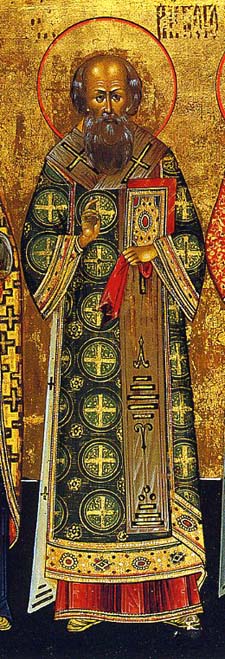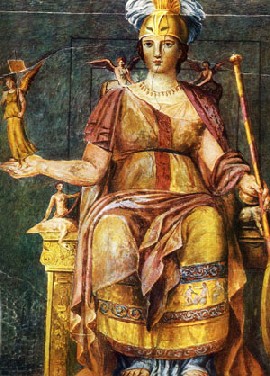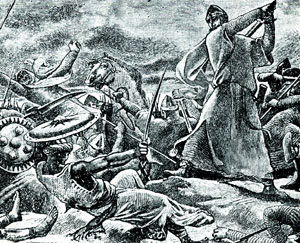 |
The Saint of the Day
St. Gregory of Nazianzus, May 9
Prof. Plinio Corrêa de Oliveira
Biographical selection:

St. Gregory of Nazianzus,
Patriarch of Constantinople
|
St. Gregory of Nazianzus, or St. Gregory Nazianzen, fourth century, was Patriarch of Constantinople and a close friend of St. Basil. A writer and orator, he fought against the Arians. He is a Father and a Doctor of the Church.
When he was already advanced in the practice of virtue and piety, Gregory was favored with a mystical vision that gave him a special esteem for chastity. He described it:
“I saw two young virgins dressed in white. They wore no superfluous ornaments, as is so common to women, but they were very beautiful. A veil covered each of their heads and also hid part of their faces. They kept their eyes modestly lowered and were silent. I felt a great joy penetrating my whole soul. I asked them who they were and whence they came.
"‘We are chastity and temperance,’ they replied. ‘We stand on either side of the throne of Christ. Join us, and we will bring you to contemplate the Eternal Trinity.’
“From that moment on, I sought out the company of those who were chaste, and renounced the pleasures of the flesh, even the legitimate bonds of matrimony. I bent myself to the yoke of temperance and frugality and dedicated myself to the reading of books about God. I also avidly read works against heretics. I continued to cultivate the arts with the sole purpose of helping me to acquire true knowledge, for I never preferred human science to the Divine Scriptures.”
Comments of Prof. Plinio:
This beautiful vision of St. Gregory of Nazianzus reflects elements of classical culture. You know that the time in which he lived was still influenced by the art and symbolism of classical Roman-Greek culture. One of the artistic customs was to symbolize virtues and qualities by abstract personages – men or women.
You can see that in this vision God Himself used the same artistic practice to make St. Gregory understand the worth of chastity and temperance. He presented them as two young ladies, equally beautiful, with a symmetric grace and charm that allowed them to stand at both sides of the throne of Our Lord Jesus Christ. That is, they are symmetric adornments for the King of glory and Redeemer of the human race.
St. Gregory described the young ladies as modest and recollected, with lowered gaze, to indicate that such virtues require one to be concerned about superior things and to avoid dissipation and superficiality. These two virtues are placed on either side of the throne of Christ to show that Our Lord has a special love for these virtues and wants to honor them in a singular way.
Why are chastity and temperance sister-virtues?
What is chastity? Chastity, you know, is abstention from the pleasures of the flesh. Even if the person is married, if both the husband and wife agree to the arrangement, perfect chastity can be practiced. It represents the complete triumph of the spirit over the flesh, a complete detachment from the flesh’s instincts to leave the spirit greater freedom to rise to higher spheres of thought, which are the proper habitation for the soul.
What is temperance? Temperance is a cardinal virtue, one of the four fundamental virtues of Catholic moral behavior. Temperance is the virtue by which the person regulates his actions following the norms of reason. Instead of conceding to the impetus of his instincts, he acts following the counsels of reason in all things. It is wise, because the first responses of the instincts are disordered; they need to be corrected and tamed. This means that there is a temperate way of speaking, eating, sleeping, studying, and doing everything else. The essence of temperance, therefore, is the submission of the instincts to the guidance of reason. Temperance is wisdom governing all human internal movements.

Above, a representation of the honor of Rome
|
What is the relation between temperance and chastity? It is simple, chastity is temperance applied to the sexual instinct. It is an aspect of temperance. But it is such an important aspect that normally it is considered as a separate virtue. This affinity of chastity and temperance explains why they appear as twin virtues that stand near the throne of Christ in St. Gregory’s vision.
This subject matter raises a parallel question that seems opportune to address. As single lay people, should we strive to acquire such virtues? Should we be chaste and temperate? Of course we should. But let me answer an objection that says the opposite.
During the pontificate of Pius XII, some second-rate theologians came up with a bizarre thesis that proposed every lay person should either marry, or become priests or religious. According to their theory, anyone who wants to be single and chaste should become a priest; if not, he or she should marry. These theologians represented a small minority, and no one learned in Church History paid any attention to them. Soon, the theory was no longer even mentioned. However, this narrow mentality remained present in some traditionalist ambiences that suffered the influence of those theologians. For this reason, still today at times we face an accusation that stems from this false view: “You cannot be lay, single and chaste; you should either marry or enter the priesthood.”
The reality is much more subtle and diversified than the simplified alternative: “Marry or be a priest.” This sophism is based on a generalization that supposes there are only two kinds of people, those able to maintain complete chastity and those who cannot. The former should not marry and serve the Church as priests or consecrated religious; the latter should marry in order not to sin and to perpetuate the species.
Even though the rule is correct, and this is actually one of the reasons for marriage, the argument is wrong because it does not consider the many exceptions the rule supposes. According to this false presupposition, it would be not possible to marry and remain a virgin, as St. Joseph and the Blessed Virgin Mary did; as St. Henry, Emperor of the Holy Roman Empire, and his wife Empress St. Cunegundes did, as well as many other saints. Also it would be impossible for a lay man to be single and be chaste as was St. Casimir, King of Poland, or St. Rose of Lima, who never became a religious. The list of saints who represent exceptions to the rule is long. But this is not my point at the moment. I mention it to show that the simple existence of such saints destroys the narrow-minded sophism.

Crusader knights dedicated themselves to defend the Holy Land, something priests could not do
|
Here I will present two other arguments. First, St. Thomas Aquinas offers a picturesque metaphor to explain the rule of marriage and chastity. He says that marriage represents the feet of mankind, since it is by means of marriage that the human race perpetuates itself and therefore walks onward. Chastity represents the eyes of mankind, given that it is by means of chaste persons that humanity sees the far horizons. He stresses that one of the main characteristics of chastity is to give broad horizons.
It is a valid comparison, because to consider only the practical aspect, married persons normally are so taken up with raising their families, they usually have little time to think of other things. The single person can maintain himself with much less effort, and therefore has more time for higher studies or causes.
If we were to take this comparison of St. Thomas, however, and apply it to the simplified rule we are refuting, “Marry or be a religious,” then the lay man or woman would be excluded from viewing the broad horizons of Christendom and the Catholic Church, which is perfectly absurd, given the enormous number of single lay people who became great warriors, politicians, scientists, poets etc., exactly because they had such horizons.
Second, it was so common in History for persons to choose to be lay, single, and chaste that they formed movements that assisted the Church in fields where ecclesiastics cannot act. For instance, what would the Middle Ages be without the knights errant, most of them living single, chaste, and turned to the defense of widows and orphans? But a priest, who is forbidden to shed human blood, could not be a knight errant.
What about the many Orders of Chivalry dedicated to defending the Catholic possessions in the Holy Land? The same is true, since ecclesiastics could not perform this task. Until today, some of these orders have a special status for their single and chaste members. How many centers of studies and arts, diverse movements that brought great benefits for Christendom – in the past or present – were made up of single chaste lay men or women? We see that the sophism incurs an erroneous generalization.
These are some lessons we can learn from the beautiful vision described by St. Gregory of Nazianzus. Let us ask him to help us to more firmly maintain and constantly increase our understanding of the fight for Christendom and the Catholic Church, and for that, to be chaste and temperate as he was.


  | | Prof. Plinio Corrêa de Oliveira | |
The Saint of the Day features highlights from the lives of saints based on comments made by the late Prof. Plinio Corrêa de Oliveira. Following the example of St. John Bosco who used to make similar talks for the boys of his College, each evening it was Prof. Plinio’s custom to make a short commentary on the lives of the next day’s saint in a meeting for youth in order to encourage them in the practice of virtue and love for the Catholic Church. TIA thought that its readers could profit from these valuable commentaries.
The texts of both the biographical data and the comments come from personal notes taken by Atila S. Guimarães from 1964 to 1995. Given the fact that the source is a personal notebook, it is possible that at times the biographic notes transcribed here will not rigorously follow the original text read by Prof. Plinio. The commentaries have also been adapted and translated for TIA’s site.
|
Saint of the Day | Home | Books | CDs | Search | Contact Us | Donate

© 2002- Tradition in Action, Inc. All Rights Reserved
|
 |

|